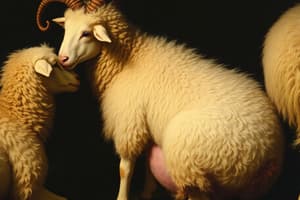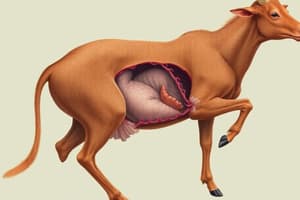Podcast
Questions and Answers
Which hormone decreases during parturition, indicating the end of pregnancy?
Which hormone decreases during parturition, indicating the end of pregnancy?
- Estrogen
- Prostaglandins
- Oxytocin
- Progesterone (correct)
What triggers the release of oxytocin during parturition?
What triggers the release of oxytocin during parturition?
- Direct stimulation of the fetus
- Increased levels of progesterone
- Prostaglandin secretion due to cervical stimulation (correct)
- Fetal cortisol decreasing
What is the primary function of prolactin in lactation?
What is the primary function of prolactin in lactation?
- Stimulating the mammary glands to produce milk (correct)
- Inhibiting milk production
- Facilitating oxytocin release
- Promoting estrogen activity
What is colostrum primarily characterized by?
What is colostrum primarily characterized by?
What physiological process prevents ovulation during lactation?
What physiological process prevents ovulation during lactation?
Which hormone is primarily responsible for stimulating smooth muscle contraction during parturition?
Which hormone is primarily responsible for stimulating smooth muscle contraction during parturition?
What role does fetal cortisol play in the process of parturition?
What role does fetal cortisol play in the process of parturition?
What is the effect of estrogen during lactation?
What is the effect of estrogen during lactation?
What is the composition of milk primarily after the first few days post-partum?
What is the composition of milk primarily after the first few days post-partum?
How does lactational amenorrhea affect hormonal fluctuations?
How does lactational amenorrhea affect hormonal fluctuations?
What triggers the release of milk during breastfeeding?
What triggers the release of milk during breastfeeding?
What is primarily inhibited during pregnancy to support lactation after delivery?
What is primarily inhibited during pregnancy to support lactation after delivery?
What is not a characteristic of colostrum?
What is not a characteristic of colostrum?
During parturition, what physiological feedback mechanism is primarily involved?
During parturition, what physiological feedback mechanism is primarily involved?
What happens to progesterone levels at parturition?
What happens to progesterone levels at parturition?
What is the primary purpose of the meiosis completed by the oocyte during fertilization?
What is the primary purpose of the meiosis completed by the oocyte during fertilization?
Which structure develops after fertilization that is crucial for implantation?
Which structure develops after fertilization that is crucial for implantation?
During which stage does the formation of the three germ layers occur?
During which stage does the formation of the three germ layers occur?
What is a primary characteristic of the cleavage stage in embryonic development?
What is a primary characteristic of the cleavage stage in embryonic development?
Which germ layer is primarily responsible for developing into the muscular and skeletal systems?
Which germ layer is primarily responsible for developing into the muscular and skeletal systems?
What consequence can teratogens have during embryonic development?
What consequence can teratogens have during embryonic development?
How do sexually transmitted infections (STIs) primarily affect an individual's reproductive health?
How do sexually transmitted infections (STIs) primarily affect an individual's reproductive health?
What is a defining feature of the process of fertilization?
What is a defining feature of the process of fertilization?
Which phase of development does cell specialization begin to occur?
Which phase of development does cell specialization begin to occur?
What is the primary role of the acrosome in sperm during fertilization?
What is the primary role of the acrosome in sperm during fertilization?
Flashcards
Parturition Trigger
Parturition Trigger
The process of giving birth, stimulated by hormonal changes, primarily originating from fetal cortisol.
Oxytocin's Role in Labor
Oxytocin's Role in Labor
A hormone that triggers powerful muscular contractions in the uterus, pushing the baby toward birth.
Lactation Hormones
Lactation Hormones
Estrogen activates prolactin, leading to milk production, while progesterone generally inhibits prolactin during pregnancy.
Colostrum
Colostrum
Signup and view all the flashcards
Lactational Amenorrhea
Lactational Amenorrhea
Signup and view all the flashcards
Parturition
Parturition
Signup and view all the flashcards
Fetal Cortisol's Role
Fetal Cortisol's Role
Signup and view all the flashcards
Prostaglandins' Role
Prostaglandins' Role
Signup and view all the flashcards
Oxytocin's Role
Oxytocin's Role
Signup and view all the flashcards
Positive Feedback during Labor
Positive Feedback during Labor
Signup and view all the flashcards
Lactation
Lactation
Signup and view all the flashcards
Prolactin's Role
Prolactin's Role
Signup and view all the flashcards
Milk Ejection Reflex
Milk Ejection Reflex
Signup and view all the flashcards
Fertilization
Fertilization
Signup and view all the flashcards
Cleavage
Cleavage
Signup and view all the flashcards
Blastocyst
Blastocyst
Signup and view all the flashcards
Gastrulation
Gastrulation
Signup and view all the flashcards
Ectoderm
Ectoderm
Signup and view all the flashcards
Mesoderm
Mesoderm
Signup and view all the flashcards
Endoderm
Endoderm
Signup and view all the flashcards
Teratogens
Teratogens
Signup and view all the flashcards
Hox genes
Hox genes
Signup and view all the flashcards
Sexually Transmitted Infections (STIs)
Sexually Transmitted Infections (STIs)
Signup and view all the flashcards
Study Notes
Parturition (Childbirth)
- Initiated by hormonal changes, some originating from the fetus, signaling completion of gestation.
- Fetal cortisol levels increase, and the fetus pushes against the cervix.
- Cervical stimulation triggers prostaglandin release, leading to uterine contractions.
- Prostaglandins stimulate oxytocin release from the posterior pituitary.
- Oxytocin causes myometrial contractions, pushing the baby towards the cervix.
- This process creates a positive feedback loop, increasing contraction frequency and intensity.
Hormonal Changes During Parturition
- Fetal cortisol, prostaglandins, oxytocin, estrogen, and progesterone are key players.
- During parturition, levels of oxytocin, estrogen, prostaglandins and cortisol are up and progesterone is down.
Lactation
- Mammary glands produce milk for the infant.
- Milk production involves 20 lobes of exocrine tissue and ducts with smooth muscle.
- Estrogen activates the prolactin pathway, increasing milk production.
- Prolactin stimulates milk production
- Progesterone inhibits prolactin (during pregnancy).
- Colostrum, the initial milk, is rich in proteins and sugars, and is produced for the first 3-4 days after delivery.
- Breast milk contains antibodies, providing passive immunity to the infant.
- During lactation, there is no change in LH, FSH, or progesterone, leading to lactational amenorrhea (no menstruation).
Studying That Suits You
Use AI to generate personalized quizzes and flashcards to suit your learning preferences.




